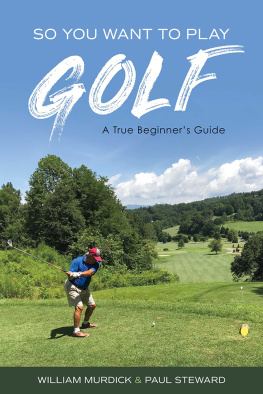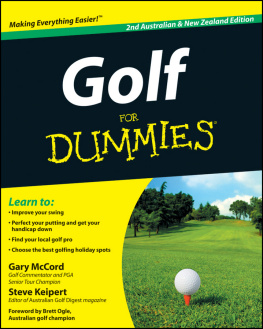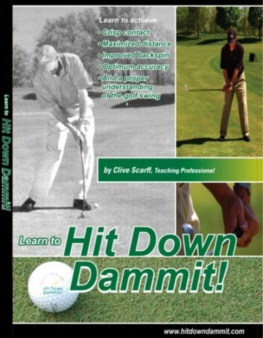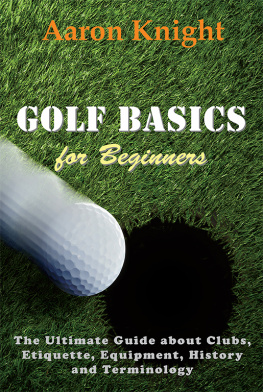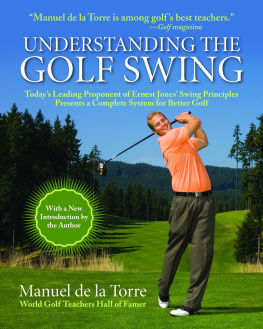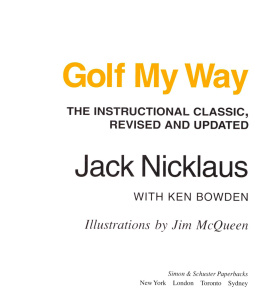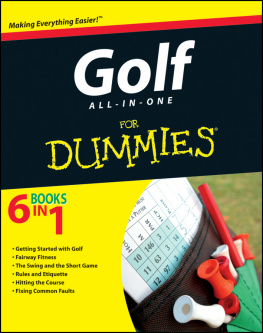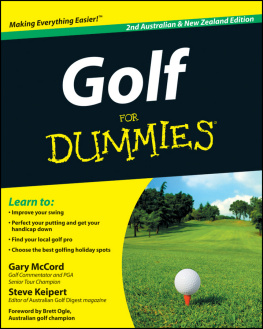So You Want to Play Golf
A True Beginners Guide
Copyright 2018 by William Murdick and Paul Steward
All rights reserved. This book or any portion thereof may not be reproduced or used in any manner whatsoever without the express written permission of the publisher except for the use of brief quotations in a book review.
ISBN (Print Edition): 978-1-54394-848-6
ISBN (eBook Edition): 978-1-54394-849-3
BookBaby Publishing
Cover Photo
82-year-old Dan Cunha of Tallahassee tees off on the 18th hole at Smoky Mountain Country Club, Whittier, NC. iPhone photo by William Murdick.
Contact Michael Cornblum at (828) 497-2772 or cornblum@dnet.net to inquire about the wonderful accommodations and affordable golf packages at Smoky Mountain CC.
Other Photos
Other photos in this book were taken by Yoshiko Murdick at Hilaman Golf Course, Tallahassee, FL. Our thanks to Jan Auger, course manager, for allowing us to use the scenic Hilaman course for a background.
Part
The Game of Golf
Chapter One
Whence Golf?
We first encounter the word golf in a document written by King James II in 1457 banning the activity. Supposedly he wanted the athletic men of his realm practicing archery instead, so they could save his butt in case of an attack. But we suspect that he may have played a round of golf himself and experienced the unique displeasure of unintentionally hitting his golf ball into a lake.
The pro golfer Raymond Floyd has his own etymological theory: They call it golf because all the other four letter words were taken.
Yes, a sense of humor is useful if you want to play this game. And some patience. There is a lot to golf. Its not like going out into a field and throwing a frisbee around. And its not just hitting a golf ball. Golf is a whole culture, with traditions regarding general attire and rules of etiquette for behavior on the golf course and in the clubhouse. The toolsthe golf clubs, golf balls, carts, GPS devices, et al.are a complex set of instruments offering many possible choices, and they should ultimately be selected with care. Even the scoring systems (note the plural) require explanation. As do the rules of the game. Hence Part 1 of this book provides an explanation of the culture you will be stepping into, if you want to play golf. It also shows you how to get into the game smoothly, without stress.
No doubt, if you are thinking about getting into golf, you are eager to get out to the practice range, if not the course itself, and start hitting golf balls. Good. Do that. Part 2 of this book will help you get started as a ball striker. But dont neglect the important information in Part 1. You cant hit a golf ball without a club and a ball, and Part 1 tells you how to choose those items and where to get them cheaply, or at a very high quality level at a very high price. And it will tell you how to behave on a golf course so that you dont irritate your fellow players and embarrass yourself with one social blunder after another.
Ideally, if you are just taking up the game, you will spend a couple of days reading Part 1, then make some preliminary purchases of equipment, and then start reading Part 2 before you ever swing a golf club. Ideally. But however you proceed is OK. This book is here for you when you need it, and if you are a typical beginner, you will need it often.
Chapter Two
The Structure of the Game
In golf, you hit a golf ball with various types of golf club. The purpose of golf is to get around a golf course in as few hits (called strokes) as possible. Courses are divided up into sets of holes, either 9 or 18, each one of which has this structure:
- a starting point, the tee box
- a fairway, a stretch of nicely cut short grass
- some rough, longer less amenable grass along the sides of the fairway and sometimes in front of the beginning of the fairway
- obstacles, such as a creek or a lake or trees or a sand bunker (a pit with sand in it)
- a green, a section of incredibly short, carpet-like grass; a typical green might be 40 feet deep by 50 feet wide.
- a hole, a buried cup in the green, which is your target; the hole will have a removeable metal stick with a flag attached to the top so it can be seen from a distance. Workers change the location of the hole on each green every day, or every other day, depending on the amount of play.
White out of bounds stakes might show up along one side of the rough. If you hit your ball across the line of those stakes, it is officially out of play and you suffer a two-stroke penalty.
Each golf hole is ranked as a par 3, par 4, or par 5. Those are the scores (the number of strokes it takes you to get the ball in the hole) that you are expected to make if you play each hole correctly, without error. The ranking assumes two putts once the ball is on the green. Putts are strokes in which you roll the ball along the ground with a special club called a putter. So on a par 3, you are expected to hit your ball onto the green in one shot from the tee box (your starting point), and then be in the hole after two putts. On a par 4, a much longer hole, it should take you two strokes to reach the green. A par 5, the longest type of hole, allows three strokes to reach the green.
The rankings are based on the length of the hole: a par 3 might be 150 yards long, a par 4 might be 375 yards long, and a par 5 might be 480 yards long. Those numbers vary on each hole depending on which tee you are using. A tee is a starting point indicated, usually, by two colored wooden blocks or metal objects set in the ground. Golf courses set up different tees and tee boxes for women, seniors, men, very good players, and tournament players or super-long hitters. Typically, red tees mark where the front-most tee position is, making for the shortest distance to the hole. Those are traditionally for women and children and are sometimes called the ladies tees. A set of yellow tees a bit further back might mark the starting point for seniors in their 60s and up. Regular mens tees, further back, are often colored white.
You paid the fee to play the course, so you can play from any tee you want to, at any age.
When men play from the ladies tees, those tees are addressed euphemistically as the front tees, to preserve the players sense of male virility. Yes, macho attitudes are a problem on the golf course, as they are everywhere else.
The Professional Golf Association (PGA) advises players to play it forward, meaning dont play from back tees out of pride, but choose tees that make sense in terms of how far you actually hit a golf ball. We, the authors of this book, advise the same. In Chapter Thirty-Six we reprint a distance table created by the two American national golf organizations, the PGA and the USGA, for determining which tees you should use.
Beginners rarely get pars. More experienced amateurs typically get 3 to 9 pars each round of 18 holes. A pro golfer, male or female, shoots a few strokes below par on a good day. That means she or he has made some birdies and possibly an eagle or two. A birdie is a score of one under par. So if you hit your tee shot onto the green on a par 3 hole, and then make your first putt for a score of 2, you have made a birdie. On a par 3, if you hit the ball into the hole on your tee shota hole in oneyou have made an eagle. Double eagles, called albatrosses, are possible on the pro circuita two on a par 5, or a hole-in-one on a par 4but put that thought out of your mind for the time being. Or forever.

